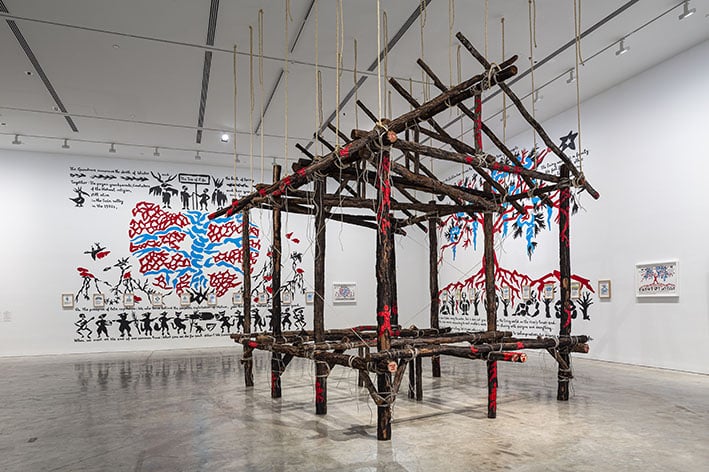
Art festival challenges Christianity
The Sydney Biennale, the city’s festival for cutting-edge global contemporary art, presents a rival future in its 2022 theme, ‘rīvus’, in which the Christian past is washed away.
In the decades since the Second Vatican Council, the Catholic vocabulary has been enriched with a glossary of new terms to describe the Church’s engagement with “the world”. “Engagement” is, of course, one of them; openness, dialogue, “reading the signs of the times”, deep listening, accompaniment, discernment, “recognising the dignity of the human person” are others.
We might add synodality to this list too, as the latest expression of an underlying orientation of contemporary Catholic thought: a deep affinity exists between the Church and the world, but the Church’s failure to listen and enter into dialogue prevents us from addressing the “spiritual hunger” of secular society.
A day spent at the 2022 Sydney Biennale should be enough to deeply challenge this worldview, and more.
The theme of this year’s exhibition, rīvus, expresses a focus on waterways, environmental health, indigenous knowledge and technology, and the rights of nature. As the Curatorium’s statement reads: “rīvus invites several aqueous beings into a dialogue … to ask unlikely questions: Can a river sue us over psychoactive sewage? Will oysters grow teeth in aquatic revenge? What do the eels think? Are the swamp oracles speaking in tongues? Do algae reminisce about the days of primordial soup?”
Rīvus is not just the Latin root of river, but of rivalry: literally, to stand on the opposite bank, to take the other fork in the stream. In its vision the Biennale Curatorium presents a rival view of life that could not be starker in its rejection of “dialogue” with the immediate Christian past, let alone the Christian present. The subjects invited to this new conversation (and ultimately, conversion) are the world’s indigenous peoples, the natural world, and the spiritual concepts and beings taken to connect the two in a way that is deeper, more authentic and less polluted with colonial violence than Christianity.
Marjetica Potrč – Artist and architect based in Ljubljana, Slovenia
Take for instance the Slovenian artist Marjetica Potrc, whose murals in the Museum of Contemporary Art, one of several Biennale locations, are pictograms of the Tree of Life, with animalistic ancestor spirits dancing beneath. The text on one mural, The Time of Humans on the Soca River, reads: “Together: the pagan grandparents, Caretakers of the Natural Religion, still alive in the Soca valley in the 1970s, and their grandchildren, Caretakers of the Land and Guardians of the Rights of Nature.” In a companion mural about the Lachlan River, Potrc writes: “The settlers speak about the wisdom of sharing … A flood is the river sharing her water with the country.”

Barthélémy Toguo – Cameroonian painter, visual and
performing artist
Upstairs, The Generous Water Giant by Barthélémy Toguo depicts a supine figure whose form erupts in a mess of hands and vines, representing “the virtues of water … an invitation to a world of solidarity and generosity”. A viewer would be forgiven for seeing instead the river Styx, with the hands of the drowning grasping for salvation above the waters.
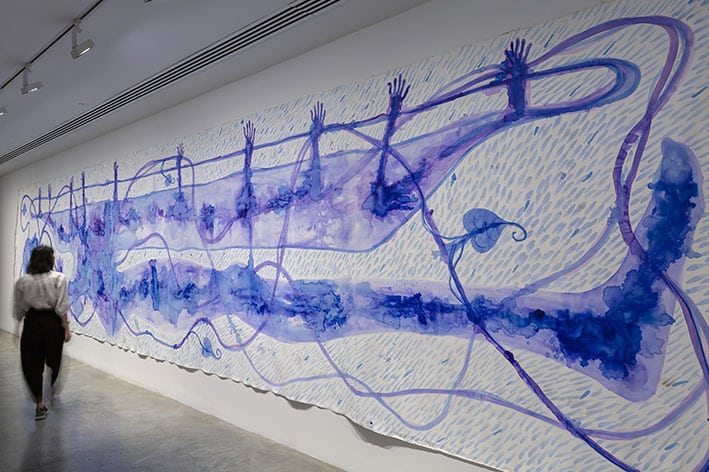
Tabita Rezaire – Artist
In the next room, a circle of stone monoliths surround a video screen in Tabita Rezaire’s Mamelles Ancestrales. The screen plays video footage of an African man discussing the stone circles as the grave of modernity. Ghouls and spirits haunt these monoliths, he says, and will kill any person who is not a devout Muslim.
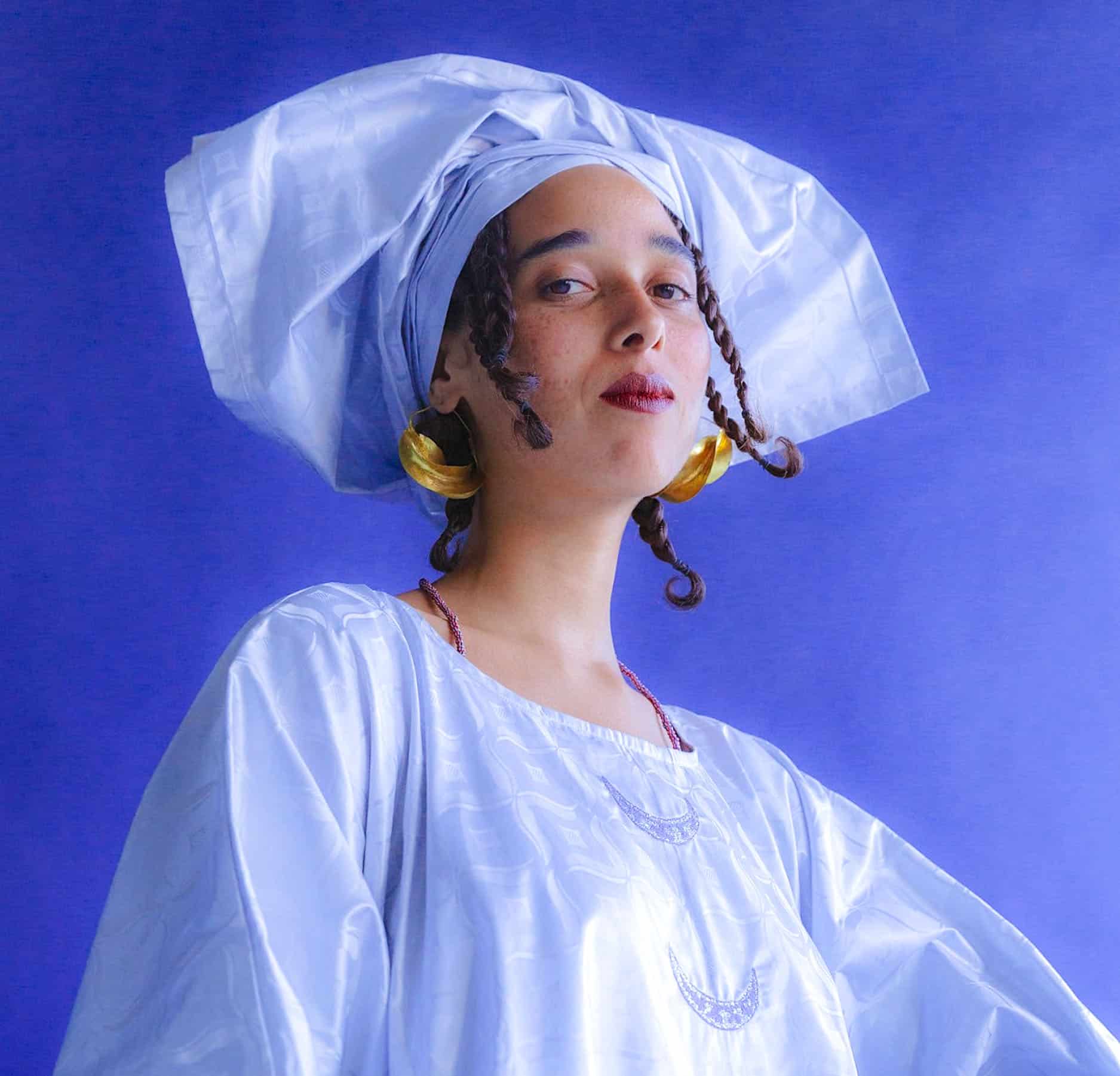
Matias Duville – Artist
The Argentine artist Matias Duville’s enormous charcoal drawings of blasted landscapes represent his “Pangeal thinking”, where geography and psychology flow into one “in a retrospective vision of the universe … an ancestral and universal brew”.
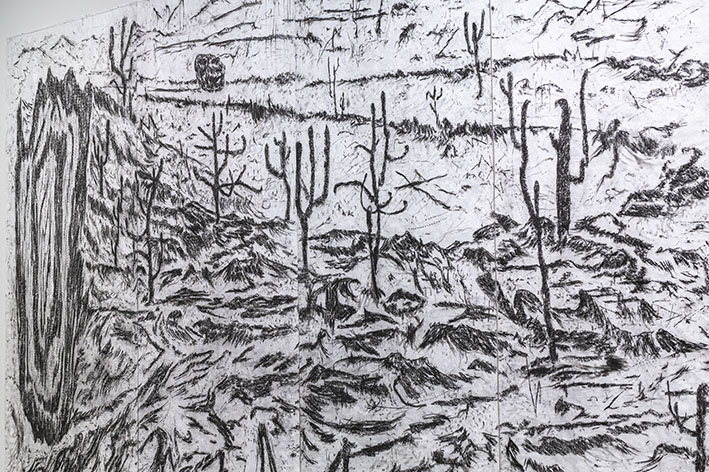
Barangaroo Cutaway
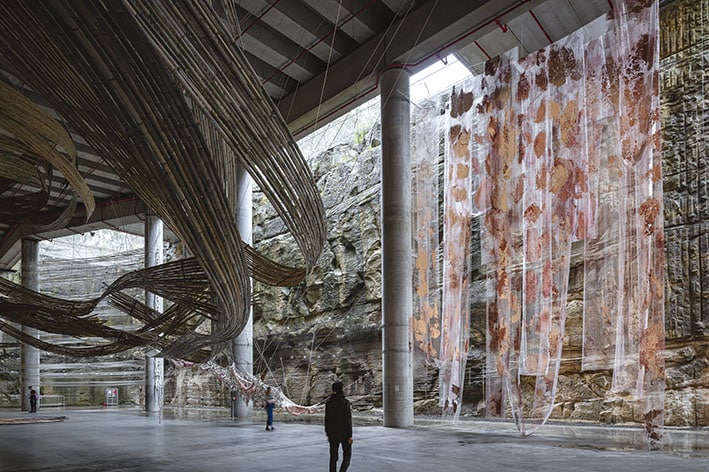
And across town, at the Barangaroo Cutaway, the cavernous space is filled with woven baskets, bamboo and fabrics, and other indigenous artefacts in enormous scale. Tucked away in a corner, behind screens, a video installation shows a small, naked man in a rainforest eating leaves and licking the tips of ferns in HD.
Julia Lohmann – German-born designer and researcher
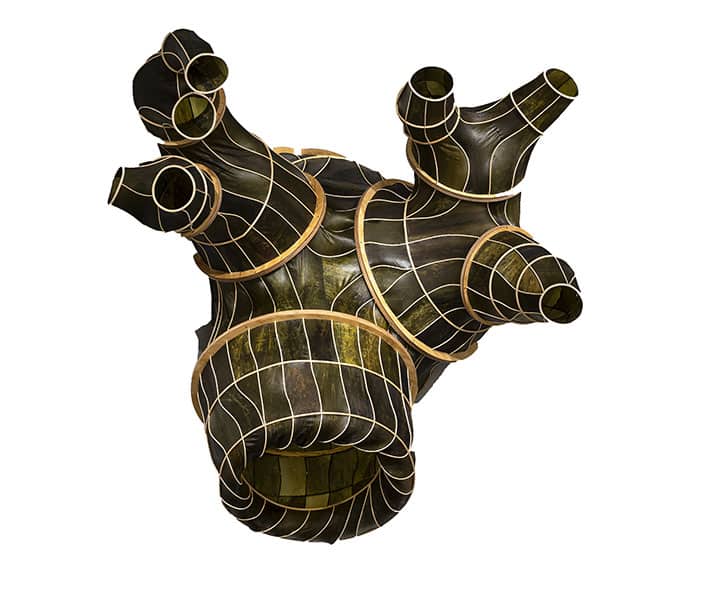
Against the backdrop of the Biennale a reorganisation of artistic priorities is also taking place.
Between rīvus and 2020’s NIRIN, the permanent collection of the Art Gallery of NSW underwent a rehang to balance out its colonial element. As part of NIRIN, black mourning veils were put over the faces of some Christian art in the permanent collection—including over the body of Christ himself, in Giulio Cesare Procaccini’s painting of the deposition with Sts Mary Magdalene, Augustine and Jerome—and other works were replaced with paintings of bruja devils.
A room of depictions of the devil
This year, the small gallery space that has in the past housed a few portraits, Renaissance depictions of the Gospels and Byzantine icons has been replaced entirely with “Of Gods and Monsters”, a room of depictions of the devil, from William Blake illustrations of the Divine Comedy to contemporary sculptures.
Just outside, a work by Lindy Lee reproduces a detail from El Greco’s The disrobing of Christ: a man drilling a hole in the cross for Christ’s crucifixion. It is entitled This too is heroic.
What is especially striking is that the overturning of the old, colonial Christian worldview also involves a critical diminution of depictions of the human person.
With a few exceptions—mostly video installations of interviews—rīvus seemed to treat human beings as a kind of taboo. Instead, the natural world speaks back to humankind in tones that range from condemnatory to patronising, asserting its rights in the face of exploitation and pollution.
Will oysters grow teeth in aquatic revenge? What do the eels think? Are the swamp oracles speaking in tongues? Do algae reminisce about the days of primordial soup?
The same condemnation is reserved for the built environment. The potential for humans to be wise cultivators of nature seems to begin and end with indigeneity. Rome, Constantinople, Jerusalem; the city as a spiritual temple of creation, from which the final apocalyptic image of the Heavenly Jerusalem is drawn, has no place in dreams of the primordial soup.
For all our talk of the dignity of the human person and a secular humanism informed by Christian “values”, the future heralded by rīvus has little room for, or interest in, such things. After a day of reading about dolphin embassies and hearing lectures on ecology by talking puffer fish, one can’t help but wonder whether any “dialogue” about personhood on purely secular terms will be possible in the near future.
Indeed, rīvus should prompt Christians to ask whether secular anthropology is robust enough to survive without a theanthropology, without Godmanhood, the unity of the divine and human in the person of Christ.
All the Christian arts are premised on this very point: Church architecture, iconography, the poetry of Dante or the journalism of Dorothy Day, let alone the painters of medieval Christendom and the Renaissance. All are inspired by a fallen humanity, body and soul, lifted up to the measure of God by grace.
We have forgotten this, but the artists have not. They are telling us that the time of the God-Man is over; the age of the oyster is here.
It’s easy enough to see all this as the preoccupation of the artistic avant-garde, who are given the Biennale to explore the fashions of contemporary art in any given year. Certainly many Catholics, if they attend the Biennale at all, may find many of these artworks reflexively repulsive.
Christianity’s rivals
But in the absence of a compelling, contemporary aesthetic witness to Christ, the task of imagining the future in and through art objects has been forcefully taken up by Christianity’s rivals.
What cannot be denied is that we have chosen this situation for ourselves. Many young Christians lament, deep in their souls, that they lack the opportunity to be formed in the their Church’s great artistic traditions.
Their parishes hardly think of themselves as aesthetic sanctuaries in an ugly “throwaway culture”, let alone mission posts for the transformation of the world into a place of beauty, sensitivity and grace.
More still object to our Church of chatter and discord, which in its drive to dialogue with the world has turned its gaze away from the ultimate Christian vision that rivals all others: the Lord, in glory, attended in silent adoration by his angels and saints.
The 23rd Biennale of Sydney continues until 13 June 2022 at multiple locations, including the Art Gallery of NSW and the Museum of Contemporary Art.
Related:
